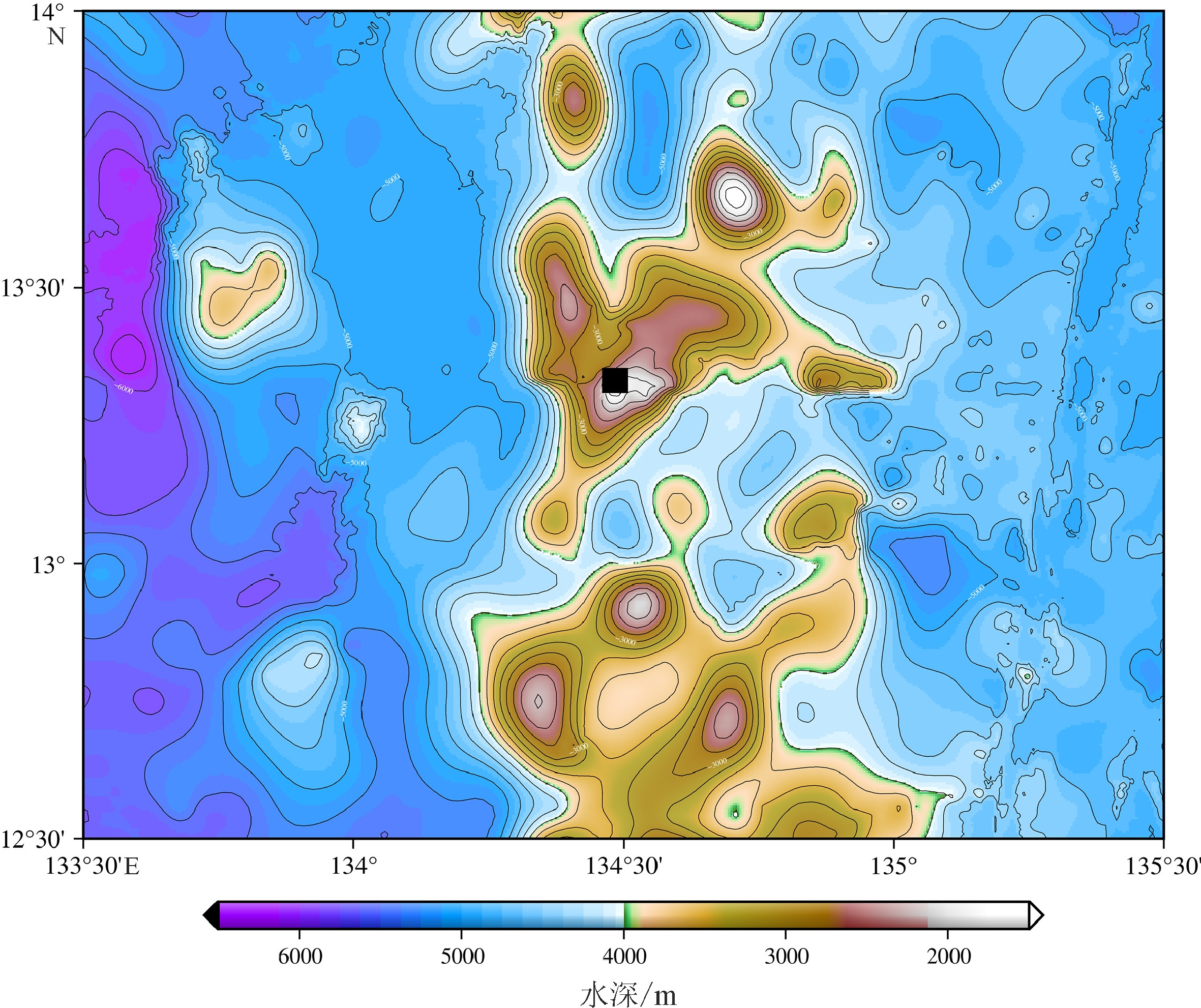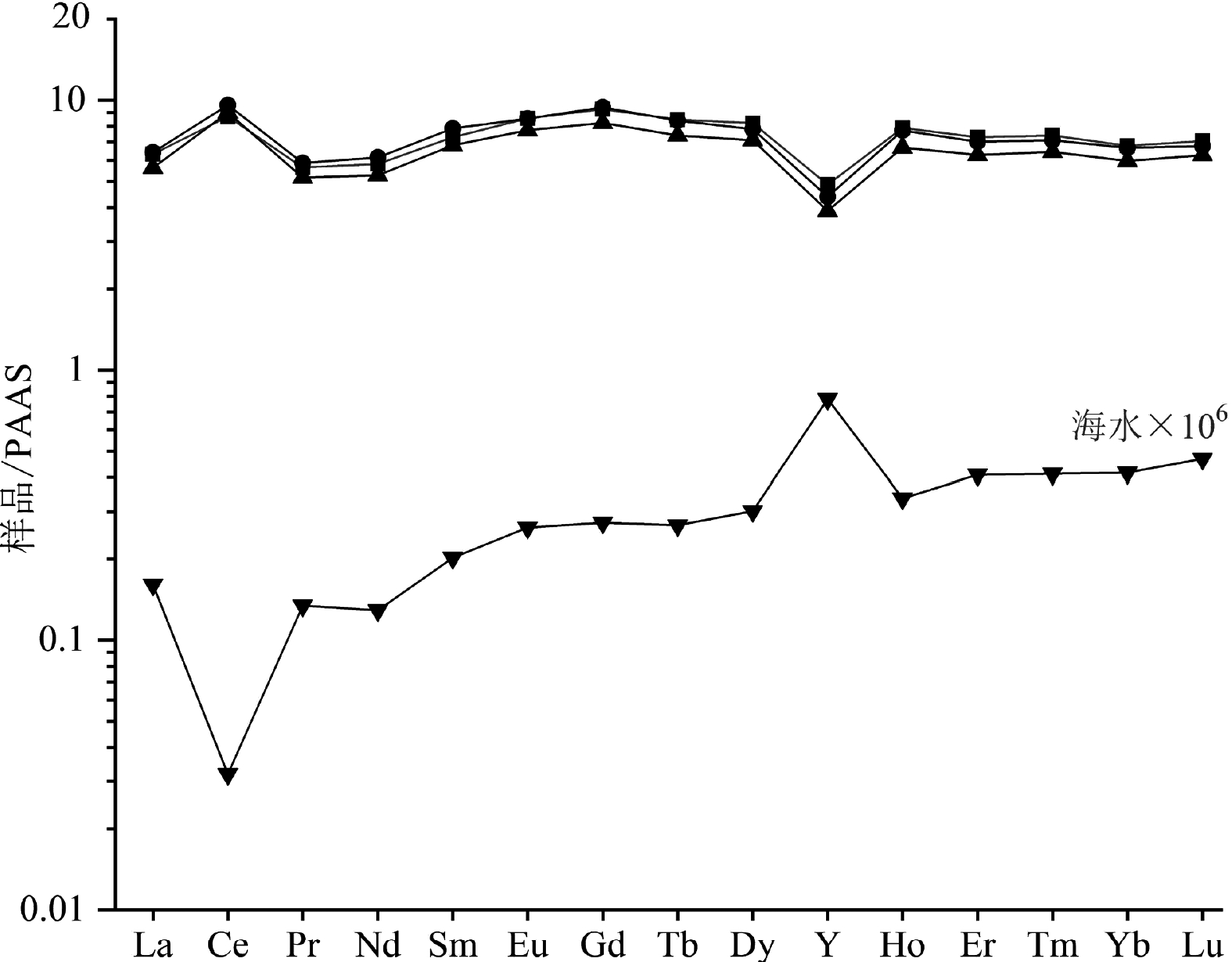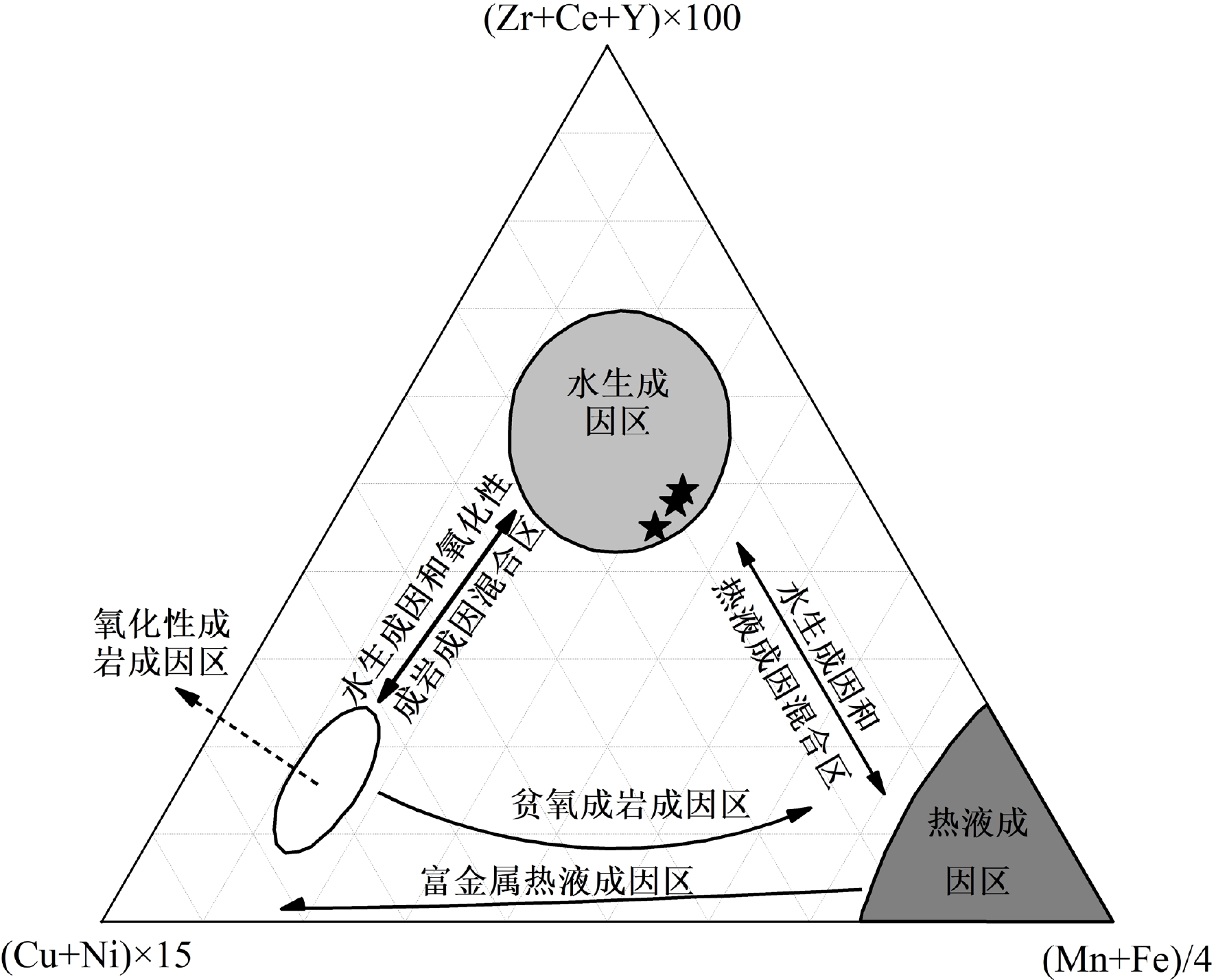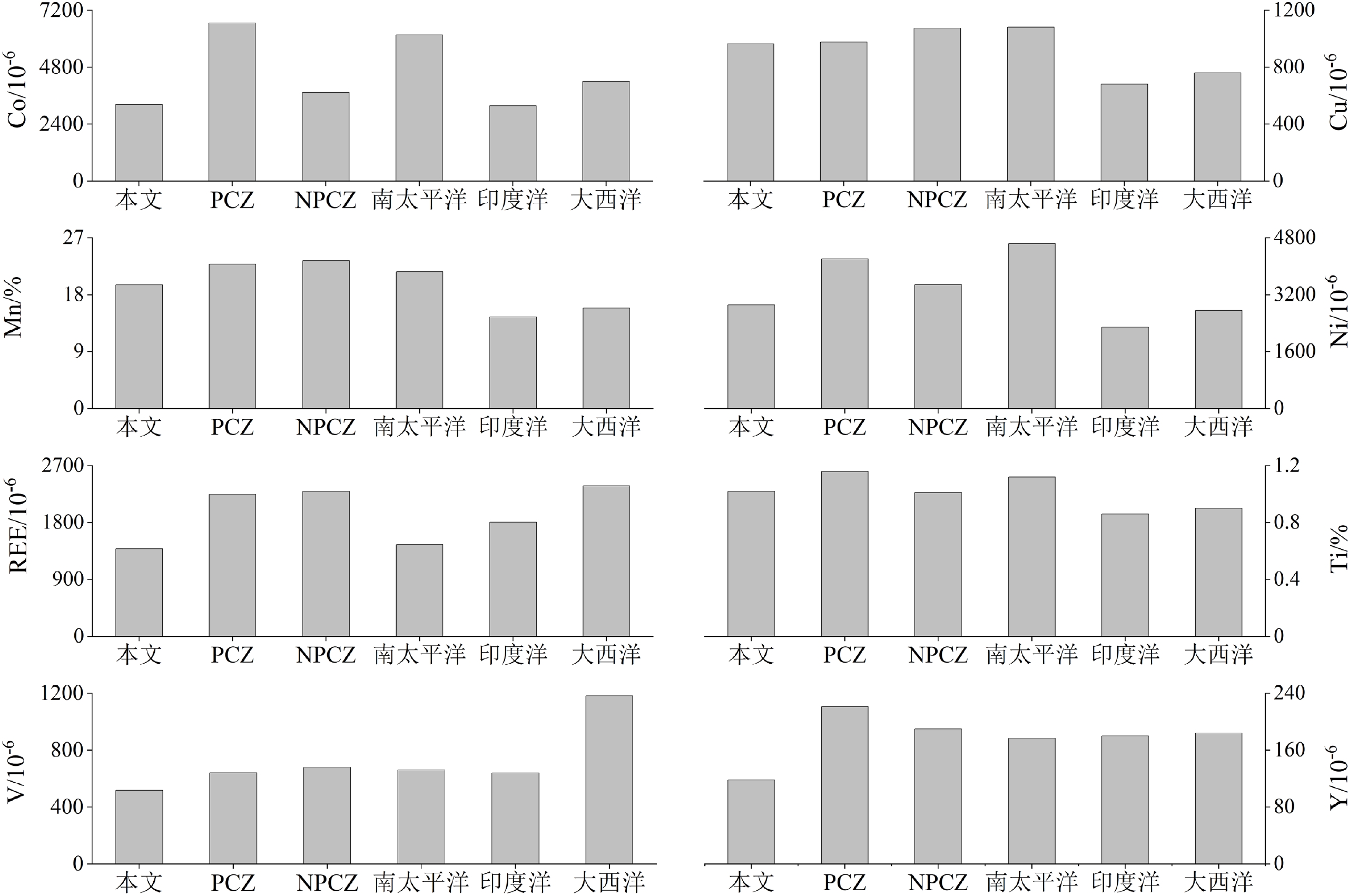Enrichment and constraints of critical metals in ferromanganese crusts from 13°20'N seamount of the southern Kyushu-Palau Ridge
-
摘要: 铁锰结壳富集Co、Cu、Mn、Ni、Ti、V、REE、Y和Zn等关键金属,研究其富集于结壳的规律以及相关地质环境制约因素对于未来开发利用这些海底金属资源十分重要。本文对九州-帕劳海脊南部13°20′N新发现的铁锰结壳样品进行了矿物学、元素地球化学和电子探针微区分析,发现其成分较为均一,未遭受明显的磷酸盐化作用,属于单层型水生成因结壳。Co、Ni等高含量关键金属主要富集在水羟锰矿内,其中主要以晶格态形式存在的Co所经历的表面氧化还原反应是其累积富集的关键;而Ni除了与Co一样通过置换Mn或占据晶格空位而呈现富集特征外,还大量以吸附态形式存在。Ti、V和REY等通过表面络合、晶格进入以及共沉淀作用富集在以六方纤铁矿为主的铁羟基氧化物组分内。Cu、Zn的晶格进入能力不足,加之海水Cu含量偏低,Zn的弱吸附作用共同导致它们以相对低含量形式分散分布。基于Co经验公式揭示结壳的形成起始于晚中新世,未出现明显生长间断,但持续生长时间不足导致结壳的关键金属累积富集程度低于全球主要结壳成矿区。不过,研究区理想的水深条件、较低的沉积速率、稳定的构造环境、合适的最小含氧带水深分布和远离非成矿物质的大规模稀释影响,都是本区结壳未来持续性增生和进一步富集关键金属的有利条件。Abstract: Ferromanganese crusts are highly enriched in a wide variety of critical metals including Co, Cu, Mn, Ni, Ti, V, REE, Y, and Zn. Study of their enrichment in the crusts and the geological constraints is important for future development and utilization of them at seafloor. Recently, ferromanganese crust samples were acquired from 13°20′N seamount of the southern Kyushu-Palau Ridge, and analyzed in mineralogy and element geochemistry, as well as for electron probe microanalysis. Results show that the mineralogical and chemical composition of the samples are relatively uniform, and the crusts have not suffered from obvious phosphatization, which indicates that the crusts are characterized by one hydrogenetic crustal layer. Critical metals with high content such as Co and Ni are mainly enriched in vernadite. Co mainly exists in the lattice of vernadite due mainly to surface oxidation of vernadite. Ni is enriched in the crusts by replacing and occupying lattice vacancies of Mn as Co does, and a large amount of Ni exists in the form of adsorption. Ti, V, and REY are enriched in the iron oxyhydroxide components dominated by feroxyhyte by surface complexation, crystal lattice entry, and co-precipitation. Cu and Zn are lack of crystal lattice entry ability; the Cu content in seawater is very low and the adsorption of Zn is weak, thus resulting in their dispersed distribution and low content in the samples. This study reveals that the crusts started growing in the late Miocene and show no obvious growth break; the accumulated enrichment degree of critical metals in these samples is lower than that in the highest potential areas of the global ocean due to insufficient continuous growth time. However, the ideal water depth conditions, low deposition rate, stable tectonic environment, suitable water depth distribution of the oxygen minimum zone, and long distance from macroscale input of the non-metallogenic material into the study area are favorable for continuous growth and enrichment of critical metals in these crusts in the future.
-
Keywords:
- ferromanganese crusts /
- critical metals /
- enrichment principles /
- constraints /
- Kyushu-Palau Ridge
-
大规模覆盖海山、海脊或海底高原顶部及侧翼区域的铁锰结壳(又称“结壳”)富集Co、Cu、Mn、Ni、Ti、V、REE、Y和Zn等人类日常生活和高新技术产业亟需的关键金属,极具资源潜力,且因生长缓慢,可记录长时间尺度的重大地质事件和海洋环境变迁而备受工业界和学术界关注[1-3]。铁锰结壳中关键金属的含量通常比周边海水、远洋黏土和玄武岩等高出1~9个数量级[4-6],展示出极高的富集度,未来可担负起陆地矿产资源接替者的角色[1, 3, 6]。因此,深入认知这些金属富集进入结壳的过程,揭示它们的富集程度差异和制约因素,进而丰富和完善全球海底结壳关键金属成矿模型,对于未来人类开发利用结壳中的这些金属资源意义重大。
南北绵延长达约2600 km,分割西菲律宾海盆与帕里西维拉海盆、四国海盆的九州–帕劳海脊是古伊豆–小笠原–马里亚纳岛弧的残留弧[7-8]。30~29 MaBP,菲律宾板块向西北运动,伊豆–小笠原–马里亚纳海沟向东后退,岛弧处的火山活动相继停止,此时主要呈北西-南东向的九州–帕劳海脊从原岛弧系统中裂开形成,且北部先于南部裂开[9-10]。15 MaBP左右,四国海盆和帕里西维拉海盆的弧后扩张停止,顺时针方向旋转至近南北向展布且东侧陡、西侧缓的九州–帕劳海脊基本形成,稳定接受沉积作用至今[7, 10]。
早在20世纪70年代末,深海钻探计划(DSDP)就在靠近九州–帕劳海脊西侧的西菲律宾海盆447号岩心沉积物内发现过小型铁锰结壳样品[11]。中国和日本科学家从20世纪80年代末到21世纪初在菲律宾海采集到大量铁锰结壳样品[12-15],但这些结壳均分布在15°N以北的九州–帕劳海脊中北部及两侧海盆内,南部海脊鲜有发现。中国地质调查局青岛海洋地质研究所海洋环境地质调查航次利用地质拖网在九州–帕劳海脊南部13°20′N的一处海山顶部斜坡水深约1750 m的地方首次采集到铁锰结壳样品(图1)。本文首先通过对样品的矿物学和元素地球化学分析,确定结壳厘米尺度下关键金属的富集特征;再结合电子探针微区分析,以去除大颗粒碎屑的影响,剖析铁锰氧化物纹层内微米尺度金属的富集状况,估算结壳的生长速率和年龄;最终揭示制约这些关键金属在结壳内漫长富集过程的地质环境因素,并与全球主要成矿区内的样品进行对比研究,探讨成矿潜力差异和原因。
1. 样品与方法
1.1 样品
本文分析的铁锰结壳样品为单层结构砾状结壳(图2),表面较为疏松,主要呈黑褐色,可见典型的瘤状凸起和凹槽,内部纹层呈亮煤色—褐煤色,较为致密。结壳各部位层厚不一,样品顶部壳层相对较厚,可超过3 cm,两侧及底部壳层较薄,通常不足1 cm。壳层内部间杂少量远洋黏土和有孔虫,基质为黏土岩。
从外到内将本文结壳样品的顶部厚壳体分为外层、中间层和内层取样(图2),在自然资源部海洋地质实验检测中心完成矿物组成的分析工作。将样品研磨至200目后送入D/Max-2500型X射线衍射仪进行分析。测试采用Cu靶,管压和管流分别为40 kV和150 mA。测试方式为步进扫描,范围5°~65°,步长为0.02°,停留时间为0.2 s。
1.2 主微量元素
结壳外层、中间层、内层以及基质样品的主微量元素含量测试工作在澳实分析检测(广州)有限公司完成。将样品研磨至200目,称取一份试样,预干燥后加入包含硝酸锂在内的硼酸锂-偏硼酸锂助熔剂,充分混合后,高温熔融。熔融物倒入铂金模子形成扁平玻璃片后,再用X 射线荧光光谱仪分析Al、Ca、Fe、Mn、Si、Ti等主量元素。此外,再称取一份试样,加入到偏硼酸锂/四硼酸锂熔剂中,混合均匀,在1025 ℃以上的熔炉中熔化。熔液冷却后,用硝酸、盐酸和氢氟酸定容,再用电感耦合等离子体质谱仪分析Co、Cu、Ni、P、REE、V、Y和Zn等微量元素。测试过程中使用了包括中国锰矿石国家标准物质GBW07266、泥质灰岩国家标准物质GBW07108以及加拿大自然资源部批准的水系沉积物标准物质STSD-1等,以监控测试准确度。
1.3 电子探针微区分析
本文的电子探针微区分析工作在中国海洋大学海底科学与探测技术教育部重点实验室完成。利用JXA-8230型电子探针对结壳顶部2.34 cm厚光片的不同部位铁锰纹层进行了化学成分分析,加速电压为15 kV,电子束电流为20 nA,束斑为5 μm。Na、Mg、Al、Si、K、Ti、P、Cl、Fe、Mn元素的计数时间为10 s,Ca、Ni、Cu元素的计数时间为20 s,Co元素的计数时间为40 s,Sr、Zn、V元素的计数时间为60 s,Ce元素的计数时间为80 s。测试各元素使用的标准样品为钠长石(Na)、透辉石(Mg、Si、Ca)、石榴石(Al)、透长石(K)、金红石(Ti)、磷灰石(P)、硅铍铝钠石(Cl)、赤铁矿(Fe)、蔷薇辉石(Mn)、合成NiO(Ni)、赤铜矿(Cu)、合成CoO(Co)、天青石(Sr)、硅锌矿(Zn)、合成玻璃(V)、五磷酸铈(Ce)。测试完成后使用软件自带的ZAF校正程序校正数据。
结壳铁锰氧化物的晶体结构中通常赋存大量的水(如水羟锰矿含有约16%~25%的水),且孔隙度较高(平均值高达60%)[1, 16],因此电子探针分析得出的元素氧化物态含量总和一般远低于100%。本文借鉴前人的研究成果,确定70%的元素氧化物态含量加和临界值[16-17],高于此值的分析结果用于进一步的研究和讨论,低于此值的分析点位则被舍弃。本文结壳光片样品的外层明显比中间层和内层更容易出现元素氧化物态含量总和低于70%的情况,这可能与外部层位较为疏松(孔隙度较大)有关。
2. 结果
2.1 矿物组成
本文铁锰结壳样品外层、中间层和内层的主要矿物类型比较相似,均以结晶度较低的水羟锰矿、六方纤铁矿和结晶度较高的碎屑矿物石英、长石为主。水羟锰矿和六方纤铁矿多以微晶、隐晶等晶形较差的细小颗粒形态出现,且混杂交织生长,谱峰叠加成宽阔的鼓包(图3)。此外,仅在样品外部层位中检出明显的方解石谱峰,这些方解石主要来自研究区碳酸盐补偿深度以浅普遍存在的有孔虫。结晶度较高的水钠锰矿和钙锰矿等在图谱中没有明显检出,而诸如水铁矿等其他铁羟基氧化物也因为粒径小、结晶度差,在图谱中线少且宽,强度也低,同样难以检出。
2.2 主微量元素含量
本文结壳样品顶部壳体外层、中间层、内层以及基质的全样主微量成分数据见表1,壳体各层位与基质成分存在显著差异。壳体各层位中含量最高的元素为Mn和Fe,其分布特征差异明显,从外层到内层,Mn含量逐步降低,为18.67%~20.68%,而Fe含量在中间层和内层远高于外层,为17.70%~18.78%,导致Fe/Mn从外层的0.86升至内层的0.99。主要有用金属中,Co的含量分布特征与Mn完全一致,为(3090~3400)×10−6,而Ni的含量分布特征与Mn、Co相似,也是外层最高、中间层和内层低,为(2620~3400)×10−6。Ti在各层位中的含量分布特征与Fe保持一致,同样为中间层最高(1.08%),外层最低(0.94%)。Cu、V、Zn的含量较低,且最高值均出现在外层,中间层和内层较低,分别为(853~1120)×10−6、(491~547)×10−6和(463~512)×10−6。REE和Y(合称REY)的含量为(1431~1579)×10−6,其在中间层最高,内层最低,且轻稀土元素(LREY:La-Eu)含量远超重稀土元素(HREY:Gd-Lu和Y)。样品主要碎屑组分元素Si、Ca和Al一致性地展示出从外层到内层逐步升高的分布特征,含量分别为5.92%~7.01%、2.31%~2.41%和1.58%~1.98%。此外,样品内外各层位中P的含量非常均一,为0.22%~0.23%。
表 1 结壳样品元素含量特征Table 1. Chemical composition of the ferromanganese crusts元素 外层 中间层 内层 基质 Al/% 1.58 1.69 1.98 7.97 Ca/% 2.31 2.36 2.41 4.26 Fe/% 17.70 18.78 18.52 11.20 Mn/% 20.68 19.44 18.67 1.35 P/% 0.23 0.23 0.22 0.09 Si/% 5.92 6.47 7.01 21.29 Ti/% 0.94 1.08 1.03 0.76 Ce/10−6 692 764 717 94 Co/10−6 3400 3220 3090 156 Cu/10−6 1120 853 927 373 Ni/10−6 3400 2620 2720 291 V/10−6 547 515 491 261 Zn/10−6 512 463 491 276 LREY/10−6 1230 1322 1202 173 HREY/10−6 274 258 229 60 REY/10−6 1503 1579 1431 233 2.3 电子探针微区成分特征
结壳样品各层位铁锰氧化物的电子探针微区成分数据见表2。Fe、Mn这两个结壳中最主要的载体元素在样品不同层位微区铁锰氧化物中的分布差异明显,从外层到内层,Fe的平均含量从19.25%升高至23.71%,而Mn的平均含量则从26.81%降至23.83%。Co、Ni的变化趋势与Mn保持一致,平均含量分别从外层的0.59%、0.65%降至内层的0.42%、0.43%,但含量分布离散程度远高于Mn。Ti的变化趋势则与Fe相似,平均含量从外层的1.16%升高至内层的1.44%。Si、Al这两个主要碎屑元素的分布特征同样与Fe保持一致,平均含量从外层的2.62%、0.64%升至内层的3.62%、0.85%。同样作为碎屑元素的Ca,其在微区铁锰氧化物中的含量分布特征与Si、Al不同,在中间层出现最高值(2.54%),而在内层出现最低值(2.24%)。Ce、Cu、P、V、Zn这5个低含量元素在内外层位中的平均含量分布较为均一,最高值(0.15%、0.14%、0.39%、0.11%、0.09%)与最低值(0.13%、0.13%、0.36%、0.09%、0.07%)之间的差异较小。
表 2 样品不同层位铁锰氧化物的电子探针微区成分数据Table 2. Element contents in the ferromanganese oxides layers from different parts of the sample revealed in electron probe microanalysis元素 Al Ca Ce Co Cu Fe Mn Ni P Si Ti V Zn 外层
(n=13)最大值/% 1.62 3.04 0.16 0.73 0.18 24.37 28.61 1.10 0.45 3.70 1.32 0.13 0.10 最小值/% 0.43 1.62 0.05 0.24 0.09 16.84 22.98 0.42 0.30 2.07 0.64 0.07 0.05 平均值/% 0.64 2.47 0.13 0.59 0.14 19.25 26.81 0.65 0.36 2.62 1.16 0.09 0.08 离散系数/% 45.98 16.64 21.87 23.60 19.89 10.58 6.06 24.58 12.97 17.90 14.80 17.29 17.38 中间层
(n=20)最大值/% 1.22 2.89 0.16 0.74 0.22 24.81 32.27 0.82 0.47 4.93 1.38 0.12 0.11 最小值/% 0.34 2.05 0.09 0.26 0.07 17.01 22.72 0.40 0.30 1.59 1.00 0.07 0.01 平均值/% 0.67 2.54 0.13 0.50 0.14 21.06 26.50 0.58 0.38 2.92 1.21 0.10 0.07 离散系数/% 29.34 7.88 14.57 25.34 24.59 11.22 9.67 23.00 14.48 26.75 8.97 13.66 33.77 内层
(n=20)最大值/% 1.77 2.61 0.19 0.75 0.20 35.47 30.66 0.75 0.48 6.40 3.14 0.14 0.14 最小值/% 0.49 1.05 0.10 0.20 0.08 16.36 11.02 0.15 0.28 1.88 1.13 0.07 0.06 平均值/% 0.85 2.24 0.15 0.42 0.13 23.71 23.83 0.43 0.39 3.62 1.44 0.11 0.09 离散系数/% 41.40 17.22 16.12 27.84 22.63 15.34 15.92 29.60 13.75 25.83 29.81 15.91 25.82 3. 讨论
3.1 结壳成因类型
样品顶部壳体的内、中、外三层的REY标准化配分模式见图4。这3个层位的配分特征十分相似,均展示出明显的Ce正异常和Y负异常分布特征,且Nd含量为(178.5~208.0)×10−6,远超100×10−6的界限值,同时CeSN/CeSN*和YSN/HoSN分别为1.46~1.67和0.57~0.62,完全满足大于1和小于1的要求,符合水生成因类型的全部指标[18]。此外,不管是样品内中外各壳层的全样成分(表1),还是微区铁锰氧化物的成分特征均显示P含量低于0.5%(表2),表明样品未遭受明显磷酸盐化作用的影响[19]。
![]() 图 4 结壳样品REY的PAAS标准化配分模式为便于显示,将海水的REY值扩大106倍;PAAS的REY含量引自文献[20]。海水的REY含量数据选择与本研究区临近且水深层位相近的海水的值,其中REE数据引自文献[21],采样区域为本研究区东面的西太平洋,水深2000 m;Y数据引自文献[22],采样区域为西南太平洋东加罗林海盆,水深1980 m。Figure 4. Shale normalized rare earth elements and yttrium contents of the ferromanganese crustsTo facilitate the display in the diagram, the REY contents of the seawater are expanded by 106 times; PAAS data are from the reference [20]. The REY data of the seawater is from the reference [21], the sampling area with the water depth of 2000 m is in the western Pacific Ocean close the study area, which is similar to the distribution depth of the samples in this paper. Y data of the seawater is from the reference [22]. The sampling area was in the east Caroline Basin of the southwest Pacific Ocean, in water depth of 1980 m.
图 4 结壳样品REY的PAAS标准化配分模式为便于显示,将海水的REY值扩大106倍;PAAS的REY含量引自文献[20]。海水的REY含量数据选择与本研究区临近且水深层位相近的海水的值,其中REE数据引自文献[21],采样区域为本研究区东面的西太平洋,水深2000 m;Y数据引自文献[22],采样区域为西南太平洋东加罗林海盆,水深1980 m。Figure 4. Shale normalized rare earth elements and yttrium contents of the ferromanganese crustsTo facilitate the display in the diagram, the REY contents of the seawater are expanded by 106 times; PAAS data are from the reference [20]. The REY data of the seawater is from the reference [21], the sampling area with the water depth of 2000 m is in the western Pacific Ocean close the study area, which is similar to the distribution depth of the samples in this paper. Y data of the seawater is from the reference [22]. The sampling area was in the east Caroline Basin of the southwest Pacific Ocean, in water depth of 1980 m.此外,最近的研究工作表明,利用高场强元素Zr和稀土元素Ce、Y,结合过渡金属Fe、Mn、Cu、Ni[23],可以有效避免仅使用过渡金属Fe、Mn、Cu、Ni、Co造成水生成因和成岩成因类型混合时难以清晰识别[24],以及仅使用稀土元素Ce、Nd、Y、Ho无法剔除磷酸盐化反应的干扰等缺陷[18],从而更清晰地将各种成因类型的结壳区分开来。本文样品成因类型判别三角图见图5,结壳的外层、中间层和内层均位于水生成因区域内,从而进一步明确本文样品主要由水生作用形成。
3.2 关键金属富集状态
本文结壳从外层到内层,各层全样样品和微区铁锰氧化物成分变化特征迥异。全样样品中,从外层到内层含量逐步升高的元素为Al、Ca和Si,逐步降低的元素为Co、Mn和V,变化较小且含量均一的元素为P,其余元素Cu、Fe、Ni、Ti、Zn和以Ce为代表的REY含量呈现出波动变化特征。与之不同的是,从外层到内层微区铁锰氧化物含量逐步升高的元素为Al、Fe、Si和Ti,逐步降低的元素为Co、Mn和Ni,波动轻微呈现一致性特征的元素为Ce、Cu、P和V,而Ca、Zn元素则展示出起伏变化特征。
Co、Ni、Ti是本文结壳样品中除Mn外含量最高的有用金属组分。Co在各层全样样品和微区铁锰氧化物纹层中均呈现出含量随层厚增加而降低的特征,这与样品中含量最高的金属元素Mn的变化趋势完全一致,而与高含量碎屑元素Si以及Al截然相反,指示出结壳内大颗粒至微粒碎屑物质对结壳全样及铁锰氧化物纹层中高含量的Mn、Co所带来的明显稀释影响,也表明Mn和Co具有明显的伴生关系。样品微区铁锰氧化物纹层内的Co与Mn、Si和Fe的相关性最强,相关系数R(表3,n=53)分别为0.75、−0.72和−0.69,而与其他元素的相关性明显减弱,指示出Co主要富集的锰氧化物内,铁羟基氧化物和硅质碎屑物质更多地扮演着稀释剂的角色。Ni在样品微区铁锰氧化物纹层中与Co一样呈现出含量随厚层的增加而降低的特征,而在全样样品中也展示出外层高、中间层和内层低的特征,且Ni与Mn、Si、Fe相关性比Co更强,R值分别为0.77、−0.76和−0.82,表明本文结壳内的Ni与Co一样主要富集在锰氧化物而非铁羟基氧化物中,这也与临近海域内水生成因型结核中Ni的富集特征相似[25]。Ti在微区铁锰氧化物纹层中的分布特征与Co、Ni相反,其含量随厚层的增加而升高,而在全样样品中也展示出外层低、中间层和内层高的特征。Ti与Fe、Mn、Si的相关性同样强于其他元素,R分别为0.76、−0.76和0.72,且在结壳基质部位,当Si的含量升高到各壳层的3倍时,Ti的含量反而降低了约26%,Fe的含量也相应下降了约39%(表1),由此可知本文结壳样品内的Ti主要富集在铁羟基氧化物内,微粒硅质碎屑组分主要与之呈现伴生关系而非载体关系。
表 3 微区铁锰氧化物纹层内各元素间的相关系数矩阵(n=53)Table 3. Pearson correlation coefficient matrix for major and valuable metal elements contained in the ferromanganese oxide layers (n=53)Al Ca Ce Co Cu Fe Mn Ni P Si Ti V Ca −0.78 Ce 0.12 −0.07 Co −0.67 0.57 −0.21 Cu −0.01 0.18 −0.13 −0.04 Fe 0.49 −0.43 0.60 −0.69 −0.06 Mn −0.72 0.67 −0.41 0.75 0.06 −0.90 Ni −0.48 0.45 −0.45 0.65 0.13 −0.82 0.77 P 0.09 0.08 0.35 −0.47 −0.01 0.68 −0.52 −0.64 Si 0.78 −0.64 0.38 −0.72 −0.04 0.87 −0.94 −0.76 0.52 Ti 0.53 −0.55 0.53 −0.37 −0.04 0.76 −0.76 −0.55 0.18 0.72 V −0.03 0.06 0.41 −0.30 0.11 0.68 −0.49 −0.50 0.63 0.46 0.40 Zn 0.17 −0.10 0.12 −0.45 0.15 0.44 −0.39 −0.47 0.50 0.40 0.12 0.45 Cu、V和Zn是本文样品中含量较低的金属组分,它们在结壳内的富集状态也不相同。Cu在结壳各层全样样品中呈现出外层高、中间层和内层低的特征,但在微区铁锰氧化物纹层中则含量基本一致,且Cu与各元素间的相关性均较差,|R|均小于0.2,指示出低含量的Cu在本文结壳内呈现相对分散分布的特征。V在各层全样样品中展示出随厚度增加而略微降低的特征,而在微区铁锰氧化物纹层中则显示出较为均一的分布特征。V与Fe、P和Mn的相关性最强,R为0.68、0.63和−0.49,且已有研究工作表明,诸如针铁矿等铁羟基氧化物强烈吸附海水中的V并控制其氧化还原状态[26],由此推断本文结壳内的V主要富集在铁羟基氧化物内并与磷酸盐组分伴生。Zn在各层全样样品和微区铁锰氧化物纹层中均呈现出含量略有波动的特征,且与所有元素的相关性均不超过0.5,显示出较为分散的分布特征,这可能与其含量较低相关。
作为REY中含量最高的Ce,其在结壳各层全样样品中呈现出外层低、中间层和内层高的特征,这与其在微区铁锰氧化物纹层内的分布特征相似。Ce与Fe、Ti的相关性最高,R为0.60和0.53,而与Mn呈现弱负相关性,R为−0.41,这表明以Ce为代表的REY主要富集于铁羟基氧化物内且与含Ti组分伴生。
3.3 制约关键金属富集的因素
海底结壳内占主体的锰氧化物和铁羟基氧化物组分分别带强负电荷和弱正电荷,且因孔隙度大、比表面积高、生长速率缓慢等特点而具备高效吸附周边海水中溶解态金属的能力,并通过表面络合、氧化还原反应以及晶格进入等作用形式将这些金属固定在结壳内[1, 3]。主要赋存在本文结壳样品锰氧化物组分中的Co和Ni,赋存在铁羟基氧化物组分中的Ti、V和REY,以及呈现分散态分布的Cu和Zn,其富集进入结壳内的机制迥异。作为结壳中最具经济价值的关键金属,氧化还原敏感元素Co在开阔大洋水体中主要以溶解态有机络合物的形式存在[27],其含量通常在最小含氧带及附近层位内因有机质的降解出现极大值,而在底层水体内出现极小值[28-29]。菲律宾海的最小含氧带底界约为1000 m,对应着北太平洋中层水[15, 30-31]。本文结壳样品位于最小含氧带底界以深仅数百米,即使在这个层位内,通常海水中溶解态Co的含量也明显低于Ni、Zn和Cu[28-29]。因此,本文结壳中锰氧化物组分对周边水体内溶解态Co的直接吸附似乎难以导致其呈现出超常富集现象。但是,发生在锰氧化物表面的高效氧化还原反应可将+2价态的Co氧化成+3价态并形成累积富集,从而弥补其在海水中相对低含量的缺陷,同时通过Co3+置换Mn而大量固定在本文占主体的水羟锰矿晶格内[1, 3],且这些Co主要占据矿物晶格质点,而不像Ni、Cu、Zn等金属还大量以吸附态形式存在[32-34],这是造成本文结壳中Co的含量略高于Ni,且远超Zn和Cu的主要原因。
开阔大洋环境下同样主要以溶解态络合物形式存在的Cu、Ni和Zn,其含量随着海水深度的增加而升高[28-29, 35],但它们在结壳中的富集程度差异明显,Ni在全样样品和微区铁锰氧化物纹层内的含量均远高于Cu和Zn。本文主要分布在以低结晶度水羟锰矿为主的层状锰氧化物内的Ni,最初因发生在表面的络合反应而被吸附[1, 36]。这些层状锰氧化物的八面体片内存在晶格空位,且因为诸如Mn3+、Ni2+、Co3+等低价态阳离子对Mn4+质点的置换而诱发层面电荷亏缺,导致以Ni2+为代表的金属阳离子为实现晶体整体电荷平衡而进入层间中央位置或者直接就位于层面空位之上或之下[34, 37]。随后,Ni2+继续通过与Mn3+/4+发生置换反应以及直接占据晶格空位而大量进入层状锰氧化物晶格内[33, 38],这与样品中含量接近的Co需要经历表面氧化反应不同。结壳中的Cu通常具有与Ni相似的表面络合反应过程,层状锰氧化物内的Ni主要分布在八面体片中,而Cu则大多分布在这些层状锰氧化物片体的边缘部位内[39]。一般情况下,开阔大洋同深度层位海水中的Cu含量数倍低于Ni[28],且Cu难以像Ni一样通过大规模置换Mn3+/4+而进入锰氧化物晶格内或是直接占据晶格空位[33, 40-42],也没有经过与Co相似的高效表面氧化还原累积过程,这些因素共同导致本文样品中Cu的富集程度远低于Co和Ni。与Cu的情况相似,本文样品内主要呈分散状分布的Zn同样展示出相对于Co、Ni的严重亏损特征,这与结壳中的Zn一般受控于弱吸附作用,且通常与低含量的Na+和Mn3+发生置换反应,难以大规模进入铁锰氧化物晶格而形成累积富集效应相关[43-44]。
主要赋存在铁羟基氧化物中的Ti和V具有相似的富集进入机制。海水中不带电荷的溶解态Ti(OH)4和TiO(OH)2易与带弱正电荷的铁羟基氧化物结合,这种高效的表面络合反应和随后的晶格进入,连同含钛离散物质在表面的直接沉淀共同导致以Ti为代表的高场强元素在本文结壳样品的六方纤铁矿等铁羟基氧化物组分中的高度富集[1, 29, 45]。此外,诸如远洋黏土、玄武岩和本文样品基质部位的高Ti含量也确保结壳中的Ti不会像Co、Ni、Mn、Cu等关键金属一样容易受到碎屑物质稀释的影响[4-5]。V主要以HVO42−和H2VO4−的钒酸盐形式溶解在开阔大洋的氧化性海水中,且容易被海洋中的铁锰氧化物和黏土矿物所吸附[29, 46]。赋存在海水和结壳内的V均主要以最高的+5价态形式存在,表明V在进入铁羟基氧化物载体相的过程中未经历过表面氧化还原反应,指示了它们在本文样品中的富集机制是表面络合或晶格进入[1, 26]。
本文结壳样品中的Ce和Y表现出与其他REY不同的分布特征。除了Ce和Y外,其他REY的配分特征与海水十分相似(图3),这是因为海水中以+3价态为主的溶解性REY络合物与主要以吸附态形式分布在结壳表面的REY络合物之间比较容易实现交换平衡[47-49]。作为氧化还原敏感元素的Ce,除了具有其他REY常见的+3价态外,还可以呈现出+4价态。海水中的Ce3+在结壳表面的初始络合反应完成后,部分Ce3+会被氧化成Ce4+,Ce4+以CeO2等难溶解形式堆积在结壳表面而不易被解吸,且海水中Ce4+物质在结壳表面的直接沉淀也会供给一定数量的Ce,从而导致Ce呈现出相对于非氧化还原敏感元素的其他REY的高度富集[50-51]。与之相反的是,Y呈现出相对于其他REY的严重亏损特征。这是因为从海水中吸附的Y在铁锰结壳体内不仅没能发生与Ce类似的氧化还原反应,而且还容易发生解吸[47-49],从而随着时间的流逝呈现出相对于其他REY的明显亏损特征。
此外,Si、Al等碎屑元素含量的高低也会显著减弱或增强以上关键金属在结壳中的富集程度。这些碎屑组分不仅会以大颗粒形式与铁锰氧化物纹层间杂伴生,而且大量以微颗粒形式进入纹层内。有研究工作针对太平洋内未发生磷酸化的铁锰结壳样品进行的顺序淋滤实验表明,Al和Si会被锰氧化物和铁羟基氧化物所吸附,其中锰氧化物吸附18%的Si和13%的Al,而铁羟基氧化物吸附28%的Si以及38%的Al[52]。本文结壳微区铁锰氧化物的Si、Al与Fe呈现正相关关系,而与Mn呈现强负相关关系(表3),表明本文样品中的微粒碎屑组分更多地与铁羟基氧化物伴生。因此,Si、Al等碎屑组分在结壳铁羟基氧化物和锰氧化物组分中的显著差异性分布,也将进一步影响这两种主要载体相内诸多关键金属的富集。
3.4 结壳的生长速率和年龄
假设本文研究区与全球其他开阔海域一样,即海底铁锰结壳开始生长后所处的周边水体对结壳的Co供给通量保持不变,且本文结壳样品内的Co主要为水生成因,碎屑组分对Co的贡献极小,Co形成后也没有在结壳各层位间发生明显的活化再迁移,符合Co经验公式估算结壳生长速率的各种条件[53-54]。本文样品各层位的全样和微区电子探针Co含量均低于0.8%,属于贫Co型结壳,因此选择对文献[55]进行校正和改进后的以下公式来计算其生长速率[56]:
GR=1.67/(50×Co/(Fe+Mn))0.47 (1)
其中,Co、Fe、Mn的含量单位为%,GR表示生长速率,单位为mm/Ma。
本文在厚度为2.34 cm的结壳顶部壳层全剖面从外到内垂直等间距测试6个微区层位,每个层位内测试邻近3—4个点,用这些点的电子探针含量平均值来代表这个层位的成分。经过公式(1)的计算,得出样品从外到内6个层位的生长速率变化范围较小,分别为2.99、1.95、2.08、1.96、2.10和2.87 mm/Ma,且没有展示出明显的生长间断,这与前人对九州–帕劳海脊中北部结壳的研究结果相一致[15]。基于以上生长速率,用相邻两个层位间的距离来除以这两个层位生长速率的平均值,可加和估算出本文结壳样品的生长年龄约为10.7 Ma,晚于本区大规模构造活动停止的时间[7, 11]。本文结壳成分的相对均一性且不间断的生长速率,暗示了晚中新世以来九州–帕劳海脊南部海域底部水体一直持续性处于氧化状态。
3.5 与全球主要成矿区结壳成分差异及原因
与全球海底结壳资源潜力最高的北太平洋结壳主要成矿区(PCZ)样品相比(图6),本文结壳样品除Cu外,其余关键金属含量均偏低,尤其是Co含量不及PCZ的一半,Mn、Ni、REE和Y含量也明显低于PCZ,指示本文研究区内结壳关键金属的富集程度及经济价值均远逊于PCZ。与同属于太平洋的北太平洋结壳非主要成矿区(NPCZ)和南太平洋内的铁锰结壳相比,本文样品除Cu、Ti外的关键金属含量同样偏低,但差距较PCZ有所减弱。与远离研究区的印度洋和大西洋结壳相比,本文样品的Cu、Mn、Ni、Ti含量较高,Co含量接近,而REE、V和Y的含量偏低。此外,本文样品的Si、Al、Ca等碎屑组分含量与PCZ等全球结壳主要成矿区样品相似[1, 3, 6],表明碎屑组分并没有明显降低本文结壳内关键金属的含量。
![]() 图 6 本文研究区与全球结壳主要成矿区内样品的关键金属平均含量对比PCZ、NPCZ、南太平洋、印度洋和大西洋铁锰结壳样品的成分数据引自文献[6]。Figure 6. Mean contents of the critical metals in the ferromanganese crusts from the research area and the highest potential areas of the global oceanThe contents of the critical metals in the ferromanganese crusts of the PCZ, NPCZ, South Pacific, Indian, and Atlantic Ocean are from the reference[6].
图 6 本文研究区与全球结壳主要成矿区内样品的关键金属平均含量对比PCZ、NPCZ、南太平洋、印度洋和大西洋铁锰结壳样品的成分数据引自文献[6]。Figure 6. Mean contents of the critical metals in the ferromanganese crusts from the research area and the highest potential areas of the global oceanThe contents of the critical metals in the ferromanganese crusts of the PCZ, NPCZ, South Pacific, Indian, and Atlantic Ocean are from the reference[6].作为结壳中最主要的载体相元素,Fe和Mn在结壳内的含量变化直接决定着其他关键金属的分布。本文外层、中间层和内层全样样品的Fe/Mn为0.86~0.99,平均值为0.94,与NPCZ(0.96)相似,高于PCZ(0.74)和南太平洋(0.83),远低于印度洋(1.57)和大西洋(1.33)的结壳[6]。因此,当各海区结壳中铁羟基氧化物和锰氧化物含量之和相当时,包括本文样品在内的太平洋结壳相对于大西洋和印度洋结壳会明显更富集赋存在Mn氧化物载体上的Co、Ni等关键金属,而亏损REE、V和Y等主要分布在铁羟基氧化物内的关键金属。此外,具有较高Fe/Mn的结壳分布的海域通常存在巨量的河流输入和广泛的热液系统,如印度洋和大西洋[57],这也可能持续性地输入大量非成矿物质,稀释关键金属的含量,导致印度洋和大西洋海底铁锰结壳关键金属含量的进一步降低。
科学界通常认为有利于海底铁锰结壳大面积分布和关键金属高度富集的条件[1-3]包括:①水深1000~2500 m且年龄大于20 Ma的大型海山或海底高原,其中尤以年龄老于65 Ma的白垩纪平顶海山为最佳;② 海区沉积速率低于2 cm/ka,且长期分布着强劲底流以清扫结壳表面的沉积物;③ 水深较浅、水团较厚且广泛分布的最小含量带;④ 与河流、风尘、火山和海底热液高供给物源区不相邻;⑤ 分布区域海底地形平缓且边坡较为稳定。
本文研究区所在的九州–帕劳海脊南部构造活动停止时间较晚,结壳生长时间不足导致层厚较薄,使得目前区域内结壳的关键金属相对于PCZ等全球主要结壳成矿区呈现出较低的富集程度和资源潜力。但是,研究区内结壳赋存水深条件较理想,沉积速率较低,最小含氧带深度分布合适,且远离陆源和地球深部物质高通量输入区[31, 58],这些都可能是导致这些结壳在未来持续性生长和进一步富集关键金属的有利因素。
4. 结论
(1)九州–帕劳海脊南部13°20′N海山顶部斜坡处新发现的铁锰结壳的矿物和化学成分较为均一,未遭受明显的磷酸盐化作用,属于单层型水生成因结壳。
(2)主要富集在结壳水羟锰矿中的高含量关键金属为Co和Ni,其中,主要以晶格态形式存在的Co累积富集的关键是吸附在样品表面的Co2+被高效地氧化成Co3+并置换Mn以及占据晶格空位,而Ni除了发生以上置换反应外,还大量以吸附态形式存在。Ti、V和REY主要富集在六方纤铁矿等铁羟基氧化物组分内,其富集存在的关键是表面络合、晶格进入以及共沉淀。Cu、Zn主要呈现出分散态,它们的晶格进入能力不足,加之海水Cu含量偏低,Zn的弱吸附作用共同导致它们展示出相对低含量的分布特征。
(3)基于Co经验公式估算结壳的生长速率为1.95~2.99 mm/Ma,年龄约为10.7 Ma,未发现明显的生长间断,暗示了晚中新世以来研究区底部水体一直持续性处于氧化状态。
(4)研究区构造活动停止时间较晚,结壳生长时间不足,是导致结壳的关键金属累积富集程度低于全球主要结壳成矿区样品的主要原因。
-
图 4 结壳样品REY的PAAS标准化配分模式
为便于显示,将海水的REY值扩大106倍;PAAS的REY含量引自文献[20]。海水的REY含量数据选择与本研究区临近且水深层位相近的海水的值,其中REE数据引自文献[21],采样区域为本研究区东面的西太平洋,水深2000 m;Y数据引自文献[22],采样区域为西南太平洋东加罗林海盆,水深1980 m。
Figure 4. Shale normalized rare earth elements and yttrium contents of the ferromanganese crusts
To facilitate the display in the diagram, the REY contents of the seawater are expanded by 106 times; PAAS data are from the reference [20]. The REY data of the seawater is from the reference [21], the sampling area with the water depth of 2000 m is in the western Pacific Ocean close the study area, which is similar to the distribution depth of the samples in this paper. Y data of the seawater is from the reference [22]. The sampling area was in the east Caroline Basin of the southwest Pacific Ocean, in water depth of 1980 m.
图 6 本文研究区与全球结壳主要成矿区内样品的关键金属平均含量对比
PCZ、NPCZ、南太平洋、印度洋和大西洋铁锰结壳样品的成分数据引自文献[6]。
Figure 6. Mean contents of the critical metals in the ferromanganese crusts from the research area and the highest potential areas of the global ocean
The contents of the critical metals in the ferromanganese crusts of the PCZ, NPCZ, South Pacific, Indian, and Atlantic Ocean are from the reference[6].
表 1 结壳样品元素含量特征
Table 1 Chemical composition of the ferromanganese crusts
元素 外层 中间层 内层 基质 Al/% 1.58 1.69 1.98 7.97 Ca/% 2.31 2.36 2.41 4.26 Fe/% 17.70 18.78 18.52 11.20 Mn/% 20.68 19.44 18.67 1.35 P/% 0.23 0.23 0.22 0.09 Si/% 5.92 6.47 7.01 21.29 Ti/% 0.94 1.08 1.03 0.76 Ce/10−6 692 764 717 94 Co/10−6 3400 3220 3090 156 Cu/10−6 1120 853 927 373 Ni/10−6 3400 2620 2720 291 V/10−6 547 515 491 261 Zn/10−6 512 463 491 276 LREY/10−6 1230 1322 1202 173 HREY/10−6 274 258 229 60 REY/10−6 1503 1579 1431 233 表 2 样品不同层位铁锰氧化物的电子探针微区成分数据
Table 2 Element contents in the ferromanganese oxides layers from different parts of the sample revealed in electron probe microanalysis
元素 Al Ca Ce Co Cu Fe Mn Ni P Si Ti V Zn 外层
(n=13)最大值/% 1.62 3.04 0.16 0.73 0.18 24.37 28.61 1.10 0.45 3.70 1.32 0.13 0.10 最小值/% 0.43 1.62 0.05 0.24 0.09 16.84 22.98 0.42 0.30 2.07 0.64 0.07 0.05 平均值/% 0.64 2.47 0.13 0.59 0.14 19.25 26.81 0.65 0.36 2.62 1.16 0.09 0.08 离散系数/% 45.98 16.64 21.87 23.60 19.89 10.58 6.06 24.58 12.97 17.90 14.80 17.29 17.38 中间层
(n=20)最大值/% 1.22 2.89 0.16 0.74 0.22 24.81 32.27 0.82 0.47 4.93 1.38 0.12 0.11 最小值/% 0.34 2.05 0.09 0.26 0.07 17.01 22.72 0.40 0.30 1.59 1.00 0.07 0.01 平均值/% 0.67 2.54 0.13 0.50 0.14 21.06 26.50 0.58 0.38 2.92 1.21 0.10 0.07 离散系数/% 29.34 7.88 14.57 25.34 24.59 11.22 9.67 23.00 14.48 26.75 8.97 13.66 33.77 内层
(n=20)最大值/% 1.77 2.61 0.19 0.75 0.20 35.47 30.66 0.75 0.48 6.40 3.14 0.14 0.14 最小值/% 0.49 1.05 0.10 0.20 0.08 16.36 11.02 0.15 0.28 1.88 1.13 0.07 0.06 平均值/% 0.85 2.24 0.15 0.42 0.13 23.71 23.83 0.43 0.39 3.62 1.44 0.11 0.09 离散系数/% 41.40 17.22 16.12 27.84 22.63 15.34 15.92 29.60 13.75 25.83 29.81 15.91 25.82 表 3 微区铁锰氧化物纹层内各元素间的相关系数矩阵(n=53)
Table 3 Pearson correlation coefficient matrix for major and valuable metal elements contained in the ferromanganese oxide layers (n=53)
Al Ca Ce Co Cu Fe Mn Ni P Si Ti V Ca −0.78 Ce 0.12 −0.07 Co −0.67 0.57 −0.21 Cu −0.01 0.18 −0.13 −0.04 Fe 0.49 −0.43 0.60 −0.69 −0.06 Mn −0.72 0.67 −0.41 0.75 0.06 −0.90 Ni −0.48 0.45 −0.45 0.65 0.13 −0.82 0.77 P 0.09 0.08 0.35 −0.47 −0.01 0.68 −0.52 −0.64 Si 0.78 −0.64 0.38 −0.72 −0.04 0.87 −0.94 −0.76 0.52 Ti 0.53 −0.55 0.53 −0.37 −0.04 0.76 −0.76 −0.55 0.18 0.72 V −0.03 0.06 0.41 −0.30 0.11 0.68 −0.49 −0.50 0.63 0.46 0.40 Zn 0.17 −0.10 0.12 −0.45 0.15 0.44 −0.39 −0.47 0.50 0.40 0.12 0.45 -
[1] Hein J R, Koschinsky A. 13. 11 - Deep-ocean ferromanganese crusts and nodules[M]//Holland H D, Turekian K K. Treatise on Geochemistry. 2nd ed. Oxford: Elsevier, 2014: 273-291.
[2] Petersen S, Krätschell A, Augustin N, et al. News from the seabed – geological characteristics and resource potential of deep-sea mineral resources [J]. Marine Policy, 2016, 70: 175-187. doi: 10.1016/j.marpol.2016.03.012
[3] Halbach P E, Jahn A, Cherkashov G. Marine Co-Rich ferromanganese crust deposits: description and formation, occurrences and distribution, estimated world-wide resources[M]//Sharma R. Deep-Sea Mining. Cham: Springer, 2017: 65-141.
[4] Li Y H, Schoonmaker J E. 9.1 - Chemical composition and mineralogy of marine sediments [M]//Holland H D, Turekian K K. Treatise on Geochemistry. 2nd ed. Oxford: Elsevier, 2014: 1-32.
[5] White W M, Klein E M. 4.13 - Composition of the oceanic crust[M]//Holland H D, Turekian K K. Treatise on Geochemistry. 2nd ed. Oxford: Elsevier, 2014: 457-496.
[6] Mizell K, Hein J R, Au M, et al. Estimates of metals contained in abyssal manganese nodules and ferromanganese crusts in the global ocean based on regional variations and genetic types of nodules [M]//Sharma R. Perspectives on Deep-Sea Mining: Sustainability, Technology, Environmental Policy and Management. Cham: Springer, 2022: 53-80.
[7] 李三忠, 赵淑娟, 索艳慧, 等. 区域海底构造-上册[M]. 北京: 科学出版社, 2021. LI Sanzhong, ZHAO Shujian, SUO Yanhui, et al. Regional Submarine Tectonics-Volume One[M]. Beijing: Science Press, 2021.
[8] Ishizuka O, Taylor R N, Yuasa M, et al. Making and breaking an island arc: A new perspective from the Oligocene Kyushu-Palau arc, Philippine Sea [J]. Geochemistry, Geophysics, Geosystems, 2011, 12(5): Q05005.
[9] 张洁, 李家彪, 丁巍伟. 九州-帕劳海脊地壳结构及其形成演化的研究综述[J]. 海洋科学进展, 2012, 30(4):595-607 doi: 10.3969/j.issn.1671-6647.2012.04.016 ZHANG Jie, LI Jiabiao, DING Weiwei. Reviews of the study on crustal structure and evolution of the Kyushu-Palau ridge [J]. Advances in Marine Science, 2012, 30(4): 595-607. doi: 10.3969/j.issn.1671-6647.2012.04.016
[10] Yamazaki T, Takahashi M, Iryu Y, et al. Philippine Sea Plate motion since the Eocene estimated from paleomagnetism of seafloor drill cores and gravity cores [J]. Earth, Planets and Space, 2010, 62(6): 495-502. doi: 10.5047/eps.2010.04.001
[11] Party Shipboard Scientific. Initial reports of the deep sea drilling project leg 59. Part I: introduction, site reports, 2, site 447: east side of the West Philippine Basin[R]. 1981.
[12] 何良彪. 马里亚纳海脊-西菲律宾海盆铁锰结核的地球化学[J]. 科学通报, 1991, 36(14):1190-1193 HE Liangbiao. Geochemical characteristics of Fe-Mn nodules and crusts from the Mariana ridge and the West Philippine Basin [J]. Chinese Science Bulletin, 1991, 36(14): 1190-1193.
[13] 陈穗田, Stüben D. 菲律宾海的锰结壳和锰结核[J]. 海洋学报, 1997, 19(4):109-116 CHEN Suitian, Stüben D. Manganese crusts and nodules in the Philippine Sea [J]. Acta Oceanologica Sinica, 1997, 19(4): 109-116.
[14] 徐兆凯, 李安春, 于心科, 等. 东菲律宾海新型铁锰结壳中元素的赋存状态[J]. 地球科学—中国地质大学学报, 2008, 33(3):329-336 doi: 10.3799/dqkx.2008.043 XU Zhaokai, LI Anchun, YU Xinke, et al. Elemental occurrence phases of the new-type ferromanganese crusts from the east Philippine Sea [J]. Earth Science—Journal of China University of Geosciences, 2008, 33(3): 329-336. doi: 10.3799/dqkx.2008.043
[15] Usui A, Graham I J, Ditchburn R G, et al. Growth history and formation environments of ferromanganese deposits on the Philippine Sea Plate, northwest Pacific Ocean [J]. Island Arc, 2007, 16(3): 420-430. doi: 10.1111/j.1440-1738.2007.00592.x
[16] Wegorzewski A V, Kuhn T. The influence of suboxic diagenesis on the formation of manganese nodules in the Clarion Clipperton nodule belt of the Pacific Ocean [J]. Marine Geology, 2014, 357: 123-138. doi: 10.1016/j.margeo.2014.07.004
[17] Heller C, Kuhn T, Versteegh G J M, et al. The geochemical behavior of metals during early diagenetic alteration of buried manganese nodules [J]. Deep Sea Research Part I:Oceanographic Research Papers, 2018, 142: 16-33. doi: 10.1016/j.dsr.2018.09.008
[18] Bau M, Schmidt K, Koschinsky A, et al. Discriminating between different genetic types of marine ferro-manganese crusts and nodules based on rare earth elements and yttrium [J]. Chemical Geology, 2014, 381: 1-9. doi: 10.1016/j.chemgeo.2014.05.004
[19] Josso P, Lusty P, Chenery S, et al. Controls on metal enrichment in ferromanganese crusts: Temporal changes in oceanic metal flux or phosphatisation? [J]. Geochimica et Cosmochimica Acta, 2021, 308: 60-74. doi: 10.1016/j.gca.2021.06.002
[20] McLennan S M. Rare earth elements in sedimentary rocks; influence of provenance and sedimentary processes [J]. Reviews in Mineralogy and Geochemistry, 1989, 21(1): 169-200.
[21] Deng Y N, Ren J B, Guo Q J, et al. Rare earth element geochemistry characteristics of seawater and porewater from deep sea in western Pacific [J]. Scientific Reports, 2017, 7(1): 16539. doi: 10.1038/s41598-017-16379-1
[22] Zhang J, Nozaki Y. Rare earth elements and yttrium in seawater: ICP-MS determinations in the East Caroline, Coral Sea, and South Fiji basins of the western South Pacific Ocean [J]. Geochimica et Cosmochimica Acta, 1996, 60(23): 4631-4644. doi: 10.1016/S0016-7037(96)00276-1
[23] Josso P, Pelleter E, Pourret O, et al. A new discrimination scheme for oceanic ferromanganese deposits using high field strength and rare earth elements [J]. Ore Geology Reviews, 2017, 87: 3-15. doi: 10.1016/j.oregeorev.2016.09.003
[24] Bonatti E, Kraemer T F, Rydell H. Classification and genesis of submarine iron-manganese deposits[M]//Horn D R. Ferromanganese Deposits on the Ocean Floor. New York: Arden House, 1972.
[25] 黄威, 胡邦琦, 徐磊, 等. 帕里西维拉海盆西缘中段铁锰结核的地球化学特征和成因类型[J]. 海洋地质与第四纪地质, 2021, 41(1):199-209 doi: 10.16562/j.cnki.0256-1492.2020101501 HUANG Wei, HU Bangqi, XU Lei, et al. Geochemical characteristics and genesis of the ferromanganese nodules in the middle western margin of the Parece Vela Basin [J]. Marine Geology & Quaternary Geology, 2021, 41(1): 199-209. doi: 10.16562/j.cnki.0256-1492.2020101501
[26] Peacock C L, Sherman D M. Vanadium(V) adsorption onto goethite (α-FeOOH) at pH 1.5 to 12: a surface complexation model based on ab initio molecular geometries and EXAFS spectroscopy [J]. Geochimica et Cosmochimica Acta, 2004, 68(8): 1723-1733. doi: 10.1016/j.gca.2003.10.018
[27] Millero F J, Woosley R, Ditrolio B, et al. Effect of ocean acidification on the speciation of metals in seawater [J]. Oceanography, 2009, 22(4): 72-85. doi: 10.5670/oceanog.2009.98
[28] GEOTRACES Intermediate Data Product Group. The GEOTRACES intermediate data product 2021 (IDP2021). NERC EDS British Oceanographic Data Centre NOC, 2021.
[29] Bruland K W, Middag R, Lohan M C. 8.2 - controls of trace metals in seawater[M]//Holland H D, Turekian K K. Treatise on Geochemistry. 2nd ed. Oxford: Elsevier, 2014: 19-51.
[30] Gong G C, Liu K K, Liu C T, et al. The chemical hydrography of the South China Sea West of Luzon and a comparison with the West Philippine Sea [J]. Terrestrial, Atmospheric and Oceanic Sciences, 1992, 3(4): 587-602. doi: 10.3319/TAO.1992.3.4.587(O)
[31] Behrens M K, Pahnke K, Schnetger B, et al. Sources and processes affecting the distribution of dissolved Nd isotopes and concentrations in the West Pacific [J]. Geochimica et Cosmochimica Acta, 2018, 222: 508-534. doi: 10.1016/j.gca.2017.11.008
[32] Manceau A, Drits V A, Silvester E, et al. Structural mechanism of Co2+ oxidation by the phyllomanganate buserite [J]. American Mineralogist, 1997, 82(11-12): 1150-1175. doi: 10.2138/am-1997-11-1213
[33] Manceau A, Lanson M, Takahashi Y. Mineralogy and crystal chemistry of Mn, Fe, Co, Ni, and Cu in a deep-sea Pacific polymetallic nodule [J]. American Mineralogist, 2014, 99(10): 2068-2083. doi: 10.2138/am-2014-4742
[34] Kuhn T, Wegorzewski A, Rühlemann C, et al. Composition, formation, and occurrence of polymetallic nodules[M]//Sharma R. Deep-Sea Mining: Resource Potential, Technical and Environmental Considerations. Cham: Springer, 2017: 23-63.
[35] Nozaki Y. A fresh look at element distribution in the North Pacific Ocean [J]. Eos, Transactions American Geophysical Union, 1997, 78(21): 221-221.
[36] Hens T, Brugger J, Etschmann B, et al. Nickel exchange between aqueous Ni(II) and deep-sea ferromanganese nodules and crusts [J]. Chemical Geology, 2019, 528: 119276. doi: 10.1016/j.chemgeo.2019.119276
[37] Peacock C L. Physiochemical controls on the crystal-chemistry of Ni in birnessite: Genetic implications for ferromanganese precipitates [J]. Geochimica et Cosmochimica Acta, 2009, 73(12): 3568-3578. doi: 10.1016/j.gca.2009.03.020
[38] Peacock C L, Sherman D M. Crystal-chemistry of Ni in marine ferromanganese crusts and nodules [J]. American Mineralogist, 2007, 92(7): 1087-1092. doi: 10.2138/am.2007.2378
[39] Wegorzewski A V, Grangeon S, Webb S M, et al. Mineralogical transformations in polymetallic nodules and the change of Ni, Cu and Co crystal-chemistry upon burial in sediments [J]. Geochimica et Cosmochimica Acta, 2020, 282: 19-37. doi: 10.1016/j.gca.2020.04.012
[40] Sherman D M, Peacock C L. Surface complexation of Cu on birnessite (δ-MnO2): Controls on Cu in the deep ocean [J]. Geochimica et Cosmochimica Acta, 2010, 74(23): 6721-6730. doi: 10.1016/j.gca.2010.08.042
[41] Little S H, Sherman D M, Vance D, et al. Molecular controls on Cu and Zn isotopic fractionation in Fe–Mn crusts [J]. Earth and Planetary Science Letters, 2014, 396: 213-222. doi: 10.1016/j.jpgl.2014.04.021
[42] Yang P, Post J E, Wang Q, et al. Metal adsorption controls stability of layered manganese oxides [J]. Environmental Science & Technology, 2019, 53(13): 7453-7462.
[43] Grangeon S, Manceau A, Guilhermet J, et al. Zn sorption modifies dynamically the layer and interlayer structure of vernadite [J]. Geochimica et Cosmochimica Acta, 2012, 85: 302-313. doi: 10.1016/j.gca.2012.02.019
[44] Hinkle M A G, Dye K G, Catalano J G. Impact of Mn(II)-manganese oxide reactions on Ni and Zn speciation [J]. Environmental Science & Technology, 2017, 51(6): 3187-3196.
[45] Hein J R, Koschinsky A, Kuhn T. Deep-ocean polymetallic nodules as a resource for critical materials [J]. Nature Reviews Earth & Environment, 2020, 1(3): 158-169.
[46] Wu F, Owens J D, Tang L M, et al. Vanadium isotopic fractionation during the formation of marine ferromanganese crusts and nodules [J]. Geochimica et Cosmochimica Acta, 2019, 265: 371-385. doi: 10.1016/j.gca.2019.09.007
[47] Bau M, Koschinsky A, Dulski P, et al. Comparison of the partitioning behaviours of yttrium, rare earth elements, and titanium between hydrogenetic marine ferromanganese crusts and seawater [J]. Geochimica et Cosmochimica Acta, 1996, 60(10): 1709-1725. doi: 10.1016/0016-7037(96)00063-4
[48] Bau M. Scavenging of dissolved yttrium and rare earths by precipitating iron oxyhydroxide: experimental evidence for Ce oxidation, Y-Ho fractionation, and lanthanide tetrad effect [J]. Geochimica et Cosmochimica Acta, 1999, 63(1): 67-77. doi: 10.1016/S0016-7037(99)00014-9
[49] Azami K, Hirano N, Machida S, et al. Rare earth elements and yttrium (REY) variability with water depth in hydrogenetic ferromanganese crusts [J]. Chemical Geology, 2018, 493: 224-233. doi: 10.1016/j.chemgeo.2018.05.045
[50] Bau M, Koschinsky A. Oxidative scavenging of cerium on hydrous Fe oxide: evidence from the distribution of rare earth elements and yttrium between Fe oxides and Mn oxides in hydrogenetic ferromanganese crusts [J]. Geochemical Journal, 2009, 43(1): 37-47. doi: 10.2343/geochemj.1.0005
[51] Marcus M A, Toner B M, Takahashi Y. Forms and distribution of Ce in a ferromanganese nodule [J]. Marine Chemistry, 2018, 202: 58-66. doi: 10.1016/j.marchem.2018.03.005
[52] Koschinsky A, Halbach P. Sequential leaching of marine ferromanganese precipitates: Genetic implications [J]. Geochimica et Cosmochimica Acta, 1995, 59(24): 5113-5132. doi: 10.1016/0016-7037(95)00358-4
[53] Josso P, Parkinson I, Horstwood M, et al. Improving confidence in ferromanganese crust age models: A composite geochemical approach [J]. Chemical Geology, 2019, 513: 108-119. doi: 10.1016/j.chemgeo.2019.03.003
[54] Puteanus D, Halbach P. Correlation of Co concentration and growth rate — A method for age determination of ferromanganese crusts [J]. Chemical Geology, 1988, 69(1-2): 73-85. doi: 10.1016/0009-2541(88)90159-3
[55] Manheim F T, Lane-Bostwick C M. Cobalt in ferromanganese crusts as a monitor of hydrothermal discharge on the Pacific sea floor [J]. Nature, 1988, 335(6185): 59-62. doi: 10.1038/335059a0
[56] Mcmurtry G M, Vonderhaar D L, Eisenhauer A, et al. Cenozoic accumulation history of a Pacific ferromanganese crust [J]. Earth and Planetary Science Letters, 1994, 125(1-4): 105-118. doi: 10.1016/0012-821X(94)90209-7
[57] Hein J R, Konstantinova N, Mikesell M, et al. Arctic deep water ferromanganese-oxide deposits reflect the unique characteristics of the Arctic Ocean [J]. Geochemistry, Geophysics, Geosystems, 2017, 18(11): 3771-3800. doi: 10.1002/2017GC007186
[58] Dutkiewicz A, Müller R D, Wang X, et al. Predicting sediment thickness on vanished ocean crust since 200 Ma [J]. Geochemistry, Geophysics, Geosystems, 2017, 18(12): 4586-4603. doi: 10.1002/2017GC007258
-
期刊类型引用(5)
1. Jingjing Gao,Jihua Liu,Hui Zhang,Shijuan Yan,Xiangwen Ren,Quanshu Yan. The occurrence phases and enrichment mechanism of rare earth elements in cobalt-rich crusts from Marcus-Wake Seamounts. Acta Oceanologica Sinica. 2024(08): 58-68 .  必应学术
必应学术
2. 丁雪,胡邦琦,赵京涛,王飞飞,黄威,李攀峰,刘佳,郭建卫,崔汝勇. 九州-帕劳海脊南段及邻近海域表层沉积物元素地球化学特征及其地质意义. 海洋地质与第四纪地质. 2023(01): 61-70 .  本站查看
本站查看
3. 丁雪,刘佳,杨慧良,赵京涛,黄威,李攀峰,宋维宇,郭建卫,虞义勇,崔汝勇,胡邦琦. 九州-帕劳海脊南段铁锰结壳物质组成特征及成因机制. 海洋地质与第四纪地质. 2023(04): 105-115 .  本站查看
本站查看
4. 黄威,胡邦琦,姜学钧,路晶芳,侯方辉,崔汝勇,李攀峰. 九州-帕劳海脊13°20′N海山铁锰结壳生长过程中Si、Al、Ca的含量变化及对碎屑物质供给的指示. 海洋地质与第四纪地质. 2023(05): 26-35 .  本站查看
本站查看
5. 王建蕊,张松,张杰. 含稀土磷矿石地球化学特征及P_2O_5富集试验研究. 非金属矿. 2023(05): 72-75+106 .  百度学术
百度学术
其他类型引用(0)




 下载:
下载:





